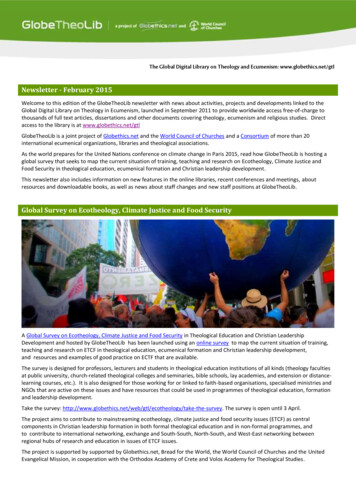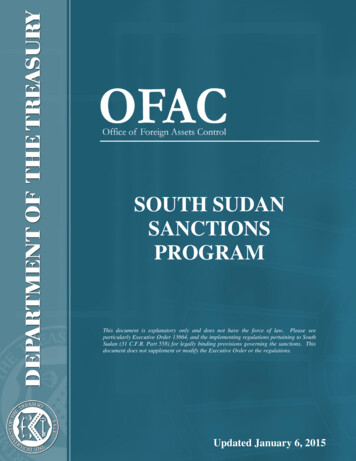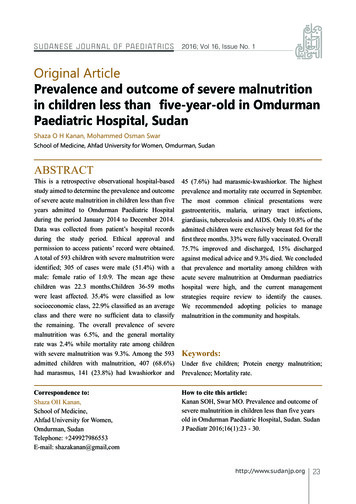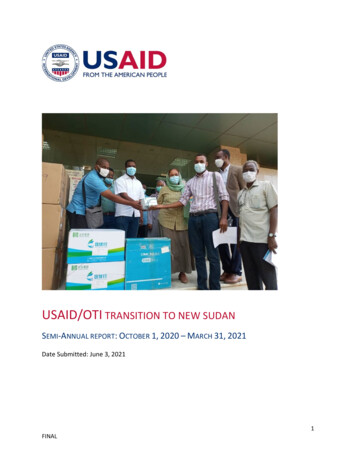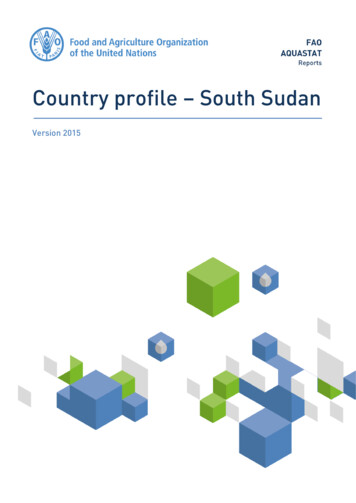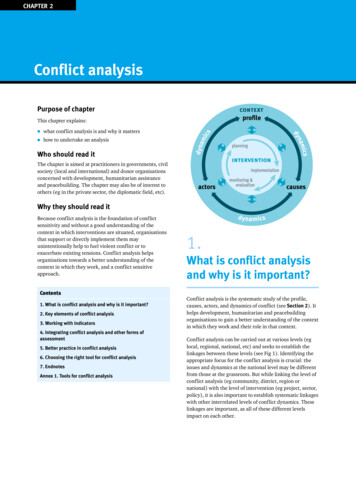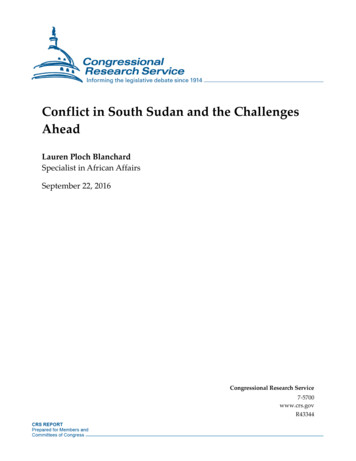
Transcription
Conflict in South Sudan and the ChallengesAheadLauren Ploch BlanchardSpecialist in African AffairsSeptember 22, 2016Congressional Research Service7-5700www.crs.govR43344
Conflict in South Sudan and the Challenges AheadSummarySouth Sudan, which separated from Sudan in 2011 after almost 40 years of civil war, was drawninto a devastating new conflict in late 2013, when a political dispute that overlapped withpreexisting ethnic and political fault lines turned violent. Civilians have been routinely targeted inthe conflict, often along ethnic lines, and the warring parties have been accused of war crimes andcrimes against humanity. The war and resulting humanitarian crisis have displaced more than 2.7million people, including roughly 200,000 who are sheltering at U.N. peacekeeping bases in thecountry. Over 1 million South Sudanese have fled as refugees to neighboring countries. Noreliable death count exists.U.N. agencies report that the humanitarian situation, already dire with over 40% of the populationfacing life-threatening hunger, is worsening, as continued conflict spurs a sharp increase in foodprices. Famine may be on the horizon. Aid workers, among them hundreds of U.S. citizens, areincreasingly under threat—South Sudan overtook Afghanistan as the country with the highestreported number of major attacks on humanitarians in 2015. At least 62 aid workers have beenkilled during the conflict, and U.N. experts warn that threats are increasing in scope and brutality.In August 2015, the international community welcomed a peace agreement signed by the warringparties, but it did not end the conflict. The formation of a Transitional Government of NationalUnity (TGNU) in late April 2016, six months behind schedule, followed months of ceasefireviolations. Opposition leader Riek Machar returned to the capital, Juba, for the first time since theconflict began, and his swearing-in as First Vice President of the new power-sharing governmentled by his rival, President Salva Kiir, was heralded as a major milestone toward peace. By lateJune, however, with little sign of subsequent progress in implementing the agreement, the head ofthe international monitoring commission warned that the peace deal was under threat of collapse.Fighting in parts of the country previously seen as stable spurred new displacement and amplifiedconcerns about a return to full-scale war.By early July, mistrust among the parties in Juba had mounted and, with the two sides havingnegotiated security arrangements that allowed armed elements in the capital, the situation quicklydeteriorated—which side started the fighting remains subject to debate, but hundreds were killedbefore ceasefires were declared on July 11. Reported attacks by government forces, includingsexual assaults and ethnically targeted killings, on civilians and aid workers during the violencehave prompted an international outcry and raised questions about the response of peacekeepers.More than 12,000 people sought shelter at the U.N. peacekeeping bases in Juba; Machar andother opposition officials fled the city and ultimately sought refuge outside the country. The statusof the unity government, and the peace agreement itself, is now in question.The United States, at the request of East African countries, has since led an international effort todeploy additional U.N. peacekeepers to Juba, with the immediate aim of providing a secureenvironment in the capital, and with the hope that the force’s presence may create conditionsmore conducive for broader stabilization efforts. The South Sudan government has been reluctantto accept the force, viewing the deployment as a possible threat to its sovereignty, and has soughtto condition its consent on approval of “modalities” for the force, including its composition.While negotiations on the force’s deployment continue, the prospects for a possible armsembargo, threatened by the U.N. Security Council in August, are unclear.Mixed messages from the international community on the status of the peace agreement and thelegitimacy of the TGNU, following President Kiir’s replacement of Machar and many of theopposition representatives in the government in late July, may complicate the path forward. ByCongressional Research Service
Conflict in South Sudan and the Challenges Aheadsome accounts, the TGNU and the peace agreement on which it was based have collapsed, andreports suggest that both sides may be preparing for a return to full-scale war.In the context of ongoing conflict, donor governments, including the United States, maydeliberate on whether, or how, to invest in proposed recovery and development efforts in thecountry. Without robust donor engagement, South Sudan’s crisis appears set to worsen—theInternational Monetary Fund warns that without economic reforms and political reconciliation,the economy will further deteriorate and the government may be unable to meet key obligations,including salaries for its army. Donor concern about state corruption, however, is high, amidreports that senior officials have diverted state assets to fuel the war, and for their own benefit.The United States, which played a key role in supporting South Sudan’s independence, has longbeen its leading donor and is a key diplomatic actor. With congressional support, the UnitedStates made major investments in South Sudan’s recovery and development after the Sudanesecivil war ended in 2005, but many of those gains have now been reversed. The ObamaAdministration has contributed over 1.7 billion in humanitarian aid since the conflict began inDecember 2013. Along with its support for the humanitarian response and ongoing developmentprograms, the United States is the largest financial contributor to the U.N. peacekeeping missionin the country and a key donor for ceasefire monitoring and other efforts to mitigate conflict. AsCongress considers available options for U.S. engagement, several key questions arise: How can the United States most effectively facilitate an end to violence and apath toward peace and reconciliation, both among political factions and rivalcommunities?Is the August 2015 peace agreement still viable? Should peace negotiations berestarted? Is the government in Juba still, in practice, a unity government?If fighting continues, what possible steps—further sanctions, an arms embargo,new types of aid, aid restrictions—would be most appropriate and mosteffective?How can the United States support efforts to pursue accountability for allegedwar crimes without a negative impact on the peace process?Given the serious abuses committed by the warring parties, what role, if any,should the United States play in the reform of a security apparatus that isexpected to combine their forces? How should the United States engage withsenior officials who have been accused of directing military operations in whichwar crimes have reportedly been committed?How can the international community help to create a more secure environmentfor aid workers, including U.S. citizens? How significant is the impact ofreported government restrictions on aid deliveries?In light of reported threats against Americans and recent assaults on U.S. citizensand incidents involving U.S. diplomats in Juba, how does the U.S. governmentcurrently assess the threat to the U.S. embassy, and to U.S. citizens in SouthSudan more broadly?What are the international community’s expectations of peacekeepers with regardto protecting civilians, and do they have the appropriate personnel, equipment,and political will to implement their mandate?What lessons have been learned from past support for state-building efforts inSouth Sudan, and how can foreign donors best support more transparent,inclusive, and accountable governance going forward?Congressional Research Service
Conflict in South Sudan and the Challenges AheadContentsBackground . 1Recent Developments . 3Humanitarian Impact of the Conflict . 4Context of the Conflict . 6Human Rights Concerns . 7International Responses to the Crisis . 9Efforts to Stabilize the Country . 10Sanctions . 14U.S. Policy and Foreign Assistance . 16Challenges Ahead . 18FiguresFigure 1. The Conflict in South Sudan: Mapping Displacement. 2AppendixesAppendix. Additional Background . 21ContactsAuthor Contact Information . 22Congressional Research Service
Conflict in South Sudan and the Challenges AheadBackgroundSouth Sudan emerged in 2011 as the world’s newest country, and one of its least developed. Afteralmost 40 years of war between the Sudan government and southern insurgents, southernSudanese voted in a January 2011 referendum to secede from Sudan. More than 2.5 millionpeople were killed in the civil war and some 4.5 million were displaced. South Sudan wasdevastated by the conflict, which hindered the development of basic infrastructure, human capital,and formal civilian institutions. Massive, chronic humanitarian needs persisted afterindependence, despite abundant natural resources, including oil fields from which Sudan hadgenerated 75% of its oil production until separation. High-level state corruption also slowed postwar recovery and development. South Sudan was the world’s largest recipient of humanitarian aidin 2013, a period of comparative stability; its needs have since grown substantially.In December 2013, political tensions among key South Sudanese leaders erupted in violence. Thepolitical dispute that triggered the crisis was not based on ethnic identity, but it overlapped withpreexisting ethnic and political grievances, sparking armed clashes and targeted ethnic killings inthe capital, Juba, and then beyond. President Salva Kiir accused his former vice president, RiekMachar, of plotting a coup, a charge Machar continues to deny. Hundreds of civilians died inensuing attacks reportedly targeting Machar’s ethnic group, the Nuer, in Juba in the first days ofthe conflict; revenge attacks by Nuer against Kiir’s ethnic group, the Dinka, followed, and theretaliatory violence spread. Machar, with the support of several senior Nuer military commanders,subsequently declared a rebellion. The conflict, between government forces and militia loyal toPresident Kiir and forces aligned with Machar, triggered mass displacement (see Figure 1),compounding the country’s vast preexisting needs and development challenges.The fighting continued unabated for more than 20 months while regional mediators made haltingprogress in peace negotiations under the auspices of the Intergovernmental Authority onDevelopment (IGAD, an East African regional entity). The warring parties periodicallyrecommitted themselves to a January 2014 cessation of hostilities deal, but repeatedly violated it.1In May 2014, they agreed to form a transitional government, but failed to agree on itscomposition and responsibilities.After missing multiple deadlines set by regional leaders to sign a deal, and under threat ofinternational sanctions, including a proposed arms embargo, the warring parties reached anagreement in August 2015. Kiir signed the deal more than a week after Machar, with reservations,calling the agreement divisive and an attack on South Sudan’s sovereignty.While both sides publicly committed to implementing the peace agreement, progress stalled afterit was signed. Major clashes between the two sides decreased, but armed conflict continued andboth sides repeatedly violated the ceasefire before coming together to form a new TransitionalGovernment of National Unity (TGNU) in late April 2016, six months behind schedule.2 Machar,1The IGAD talks were hosted by Ethiopia. IGAD also managed the ceasefire monitoring mission. In March 2015,IGAD unveiled a new “IGAD-plus” mediation mechanism with a greater role for the United States, the African Union,Europeans, the United Nations, and China. A parallel, complementary effort by Tanzania to host an intra-party dialogueprovided a venue for the rival factions to address political grievances—under its auspices the warring partiesacknowledged collective responsibility for the conflict.2The TGNU is based on a power-sharing formula, with 53% of cabinet posts held by Kiir’s faction, 33% by Machar’s,7% by a group of former political detainees (senior ruling party members arrested at the onset of the conflict), and 7%by other political parties. President Kiir retained his position, a new First Vice President position was created for theopposition, and the incumbent vice president, James Wani Igga, kept his post. Machar was to appoint state governorsfor Unity and Upper Nile States. The two sides’ armed forces were to be cantoned and then unified within 18 months.Congressional Research Service1
Conflict in South Sudan and the Challenges Aheadas leader of the armed opposition, returned to Juba to assume the new post of First Vice President,and a new cabinet was formed under a power-sharing formula. Mediators’ efforts to get theparties to agree to demilitarize the capital failed, and when Machar returned to Juba, he did sowith a security detail of 1,370, as per IGAD-led negotiations following the August 2015 deal.Ceasefire monitors were unable to confirm the government’s compliance with the securityarrangements, under which many of its own troops were to withdraw from the city. By someaccounts, as many as 10,000 or more government forces remained in and around Juba.Figure 1. The Conflict in South Sudan: Mapping DisplacementSource: CRS graphic created by Amber Wilhelm.Notes: Displacement figures include those displaced during the current conflict and refugees who fled pre-2013.Congressional Research Service2
Conflict in South Sudan and the Challenges AheadRecent DevelopmentsThe unity government’s formation did not end the war—clashes have continued, notably in areasthat were comparatively calm in the first two years of the conflict. Violence around one of thecountry’s largest cities, Wau, in Western Bahr el Ghazal, and in parts of the greater Equatoriaregion has caused mass displacement.3 A common feature of the conflicts in these areas are thegrievances expressed by local communities, who have accused the army and allied militia of landgrabs, looting, predatory attacks on civilians, and extrajudicial killings of perceived oppositionsupporters.4 Anti-government elements in these areas have reportedly sought to exploit thetensions. President Kiir’s October 2015 decree, which divided the country’s 10 states into 28, alsoappears to have exacerbated local tensions. Critics contend that the new boundaries have alteredthe states’ ethnic balance and intensified local competitions over land and resources.5Mistrust was high in Juba after the opposition’s return, and the unity government made littleprogress on key aspects of the peace deal. In early July, a series of incidents between the parties’forces in Juba sparked days of intense fighting in the city. Accounts by the two sides differ, and todate there has been no credible independent confirmation as to which side ultimately boreresponsibility.6 A clash between a small number of opposition and government forces on July 7escalated tensions and possibly contributed to several incidents that evening in which diplomaticvehicles in the city sustained gunfire. In one of those incidents, a U.N. official was wounded; inanother, two U.S. embassy vehicles, carrying seven Americans, sustained heavy fire fromgovernment forces at a roadblock (the vehicles were armored and no one was injured). StateDepartment officials have publicly stated that they have no evidence that the vehicles, which borediplomatic plates, were specifically targeted, but that incident and others have nonetheless raisedquestions about the safety of U.S. diplomatic personnel and other expatriates in Juba.7On July 8, fighting broke out between the forces of Kiir and Machar during a press conferenceheld by the two leaders. Both sides sustained casualties; members of Machar’s security detailoutside were all reportedly killed. Kiir subsequently provided Machar with a security escort to hisresidence. Juba was quiet on July 9, the anniversary of South Sudan’s independence, but fightingbroke out on the 10th and quickly spread across the city. On July 10 and 11, violence wasreportedly intense in parts of the capital, including in the area near the U.N. base that shelteredmore than 28,000 civilians and U.N. staff. The U.N. site, near both an army base and a majorcantonment site for the opposition forces, sustained artillery fire and mortar rounds—severalcivilians inside were killed, U.N. staff were wounded, and two Chinese peacekeepers were killed.U.N. peacekeepers, based at two sites in the city, did not go out on patrol, reportedly restricted bythe fighting and government constraints on their movement.8 Government restrictions on U.N.3More than 80,000 people have been displaced around Wau since June, including over 41,000 in town and 37,000outside. Of those displaced in town, more than 24,400 have sought shelter at an UNMISS-protected area near its base.4See, e.g., Small Arms Survey, Conflict in Western Equatoria, July 25, 2016; Human Rights Watch, “South Sudan:Civilians Killed, Tortured in Western Region,” May 24, 2016; and U.N. Security Council, Report of the SecretaryGeneral on South Sudan, S/2016/552, June 20, 2016.5See, e.g., Amanda Sperber, “South Sudan’s Next Civil War is Starting,” Foreign Policy, January 22, 2016.6In the week preceding the fighting, the opposition had accused the government of killing two of its officers, amongother incidents. In the aftermath of the July clashes, the government has accused Machar’s faction of attempting a coup.7This was not the first instance of government troops firing on a U.S. embassy vehicle in Juba—in November 2014, asoldier fired shots at a U.S. diplomatic convoy carrying the U.S. ambassador.8By some accounts, the deaths of the Chinese peacekeepers could have been prevented if they could have been movedto the other U.N. base, which had a hospital, after they were injured. See Matt Wells, “The U.N. has failed itspeacekeepers in S Sudan,” Al Jazeera, September 10, 2016.Congressional Research Service3
Conflict in South Sudan and the Challenges Aheadmovement persisted for several days after the fighting stopped on the evening of July 11, whenKiir and Machar both issued orders for a ceasefire. The opposition forces were outmanned andoutgunned by the army, which reportedly used attack helicopters, tanks, armored vehicles, andheavy weapons during the fighting. Surviving opposition forces fled Juba (some also reportedlyfled to the U.N. bases). Machar, whose residence was destroyed, also fled and was reportedlypursued by government forces for weeks; he ultimately sought refuge outside the country.Government forces have been accused of serious abuses against civilians during the fighting inJuba and afterward, including extrajudicial killings, enforced disappearances, looting andproperty destruction, and sexual violence.9 The targeting of Machar’s ethnic group, the Nuer, wasreportedly prevalent, including in reported house-to-house searches. A Nuer journalist workingfor USAID grantee Internews, for example, was reportedly summarily executed during the July11 attack on Terrain Camp, a residential compound popular with aid workers and otherexpatriates. U.S. citizens were physically assaulted during that incident and several women wereraped. In line with other accounts, U.S. officials assess that government forces were theperpetrators, and the U.N. Panel of Experts has concluded that the attack was well coordinatedrather than an opportunistic act.10 The attack sparked international outrage and promptedquestions about the government’s control of its forces and about the lack of response from U.N.peacekeepers, who were only a short distance away. According to witness accounts, U.S. citizenswere specifically targeted for abuse by some of the attackers.11 The government’s internal securityforces eventually rescued the victims several hours into the attack. President Kiir established acommission of inquiry on the incident in August. Some soldiers have reportedly been arrested forlooting at the compound, but to date there appears to have been little progress in bringing chargesagainst those responsible for the rapes and other assaults.Humanitarian Impact of the ConflictSouth Sudan, alongside Syria, Iraq, and Yemen, is currently classified by the United Nations asone of four “Level 3” (the highest level) humanitarian emergencies in the world, and the only onein Africa.12 U.N. officials estimate that at least 50,000 people have been killed since the conflictbegan, but no reliable death count exists, and some experts suggest the toll may be much higher.13More than 2.7 million people have been displaced since December 2013. At least 1.7 millionpeople are displaced internally, and in September 2016 the number of refugees surpassed 1million (see Figure 1). The clashes in July and rising insecurity beyond Juba have sparked a newwave of flight from the country—according to the latest U.N. estimates, more than 160,000people have fled to neighboring Uganda since the beginning of July.14 Many of those arriving in9U.N. Office of the High Commissioner for Human Rights, “SPLA committed widespread violations during and afterJuly fighting in South Sudan – Zeid,” August 4, 2016.10Testimony of Special Envoy Donald Booth, House Subcommittee on Africa, Global Health, Global Human Rightsand International Organizations, The Growing Crisis in South Sudan, September 7, 2016; U.N. Security Council,Report of the Panel of Experts on South Sudan, S/2016/793, September 19, 2016.11Jason Patinkin, “Rampaging South Sudan troops raped foreigners, killed local,” Associated Press, August 15, 2016.12‘Level 3’ emergencies are “major sudden onset humanitarian crises triggered by natural disasters or conflict whichrequire system-wide mobilization.” The U.N. Office of the Coordinator for Humanitarian Affairs makes thedesignation.13“U.N. official says at least 50,000 dead in South Sudan war,” Reuters, March 2, 2016. See also Peter Martell,“50,000 and not counting: South Sudan’s war dead,” Agence France-Presse, November 15, 2014.14UNHCR, Uganda: Emergency Update on the South Sudan Refugee Situation, Inter-Agency Daily #40, September15-16, 2016.Congressional Research Service4
Conflict in South Sudan and the Challenges AheadUganda (almost 90% of whom are women and children) have reported threats from armed actorsas they fled, including killings, rape, looting, and child abductions.U.N. Protection of Civilian (POC) SitesAlmost 200,000 people in South Sudan now reside in U.N. Protection of Civilian (POC) sites—camps for thedisplaced that are secured by peacekeepers at or near their bases. The influx of South Sudanese seeking protection atU.N. bases around the country when the war started was an unprecedented situation for the U.N., and the sites,which were never intended for large, long-term settlements, have now sheltered tens of thousands for almost threeyears. Many of the camps are overcrowded and living conditions are poor. More than 40,000 people—many ethnicNuer—are now sheltering at the U.N. bases in Juba (over 12,000 people fled there during the July fighting and, todate, a majority have remained). By numerous accounts, many fear that they may be targeted based on political orethnic affiliation if they leave.15 Tensions among communities in some sites remain a concern—in February, 30 peopledied in clashes and a fire at the POC site in Malakal; government troops were reportedly involved in the event, duringwhich 3,700 shelters were destroyed. Peacekeepers struggle to provide security inside the camps, and beyond.16The war and resulting displacement have severely exacerbated humanitarian needs in a countrythat already had some of the world’s lowest human development indicators.17 The conflict hasdisrupted farming cycles, grazing patterns, and trade routes, and local markets have collapsed.Many of the displaced lost their livelihoods when they fled their homes. Food prices haveskyrocketed since the July fighting, leaving many unable to meet basic needs. The annualinflation rate surged to almost 730% in August 2016, with food costs rising almost 850%. Therepeated looting of aid stocks has deterred aid agencies from pre-positioning supplies in manyareas, and logistical challenges and ongoing insecurity have necessitated the costly delivery offood by air, and sometimes via air drops. The looting of the World Food Program’s mainwarehouse in Juba, reportedly by government soldiers, during the fighting in July resulted in theloss of 4,500 metric tons of food, which would have fed 220,000 people for a month.U.N. officials estimate that over half the country needs humanitarian aid and that more than 4.8million people—roughly 40% of the population—face life-threatening hunger. With the onset ofharvest season in August, marginal improvements in food security are expected in the near term,but experts note that the extent of hunger is “unprecedented,” with parts of the country alreadyfacing possible famine conditions.18 (Access challenges and insufficient data reportedly hinder aidagencies’ ability to determine whether conditions meet the technical definition of famine.)19The operational environment for aid agencies is deteriorating. Without security improvements asthe dry season approaches, “the situation could rapidly become catastrophic,” according to theU.N. Food and Agriculture Organization (FAO). Some households in Northern Bahr el Ghazal arealready classified as in “catastrophe”—the most severe stage of food insecurity, with starvation15International Organization on Migration, If We Leave We Are Killed: Lessons Learned from South Sudan Protectionof Civilian Sites 2013-2016, May 5, 2016 and Aditi Gorur, Perceptions of Security Among Internally DisplacedPersons in Juba, South Sudan, Stimson Center, September 2014. The later study found that many POC residents inJuba feared attack by government forces on the camps and perceived threats of rape, abduction, beatings, or killing,based on their ethnicity. Some residents left the sites periodically for supplies, to go to school or the bank, but mostminimized time outside. Some, particularly men with traditional facial markings, did not leave for fear of attack.16See Civilians in Conflict (CIVIC), Within and Beyond the Gates: The Protection of Civilians by the U.N. Mission inSouth Sudan, October 7, 2015 and A Refuge in Flames: The February 17-18 Violence in Malakal POC, April 22, 2016.17South Sudan has the world’s highest population growth rate (over 4%), and the highest maternal mortality rate. Overhalf of the country’s children are not in school, according to UNICEF, the highest proportion in the world.18U.N. Food and Agriculture Organization (FAO), South Sudan: Situation Report – 6 September 2016.19A famine declaration requires evidence of an extreme lack of food in at least 20% of households in an area, acutemalnourishment in 30% of children, and a crude death rate over 2 deaths per 10,000 people in the affected area per day.Congressional Research Service5
Conflict in South Sudan and the Challenges Aheadevident. Hunger in that area has driven tens of thousands into the neighboring Darfur region ofSudan as refugees. The conflict also affects humanitarian access to some 260,000 Sudaneserefugees sheltering in camps in South Sudan.Context of the ConflictThe current crisis reflects underlying tensions and mistrust among South Sudanese leaders andethnic groups that date back to Sudan’s civil war (1983-2005), and before (see Appendix). Whilethe war was described broadly as a north-south conflict, infighting among southern rebelcommanders in the 1990s nearly derailed the southern bid for self-determination. Leaders of theinsurgency, the Sudan People’s Liberation Movement/Army (SPLM/SPLA), damaged their causeby competing for power and mobilizing supporters along ethnic lines; all sides committedatrocities. Khartoum fueled SPLM splits by financing and arming breakaway factions, notablyincluding forces led by Machar. The major factions reconciled in the early 2000s, althoughseveral smaller southern militias continued to operate, primarily in the Greater Upper Nile area.In 2005, the Sudanese government and the SPLM signed the Comprehensive Peace Agreement(CPA) to end the war. That deal paved the way for 2010 elections and the southern referendum,after which South Sudan, led by the SPLM, seceded in July 2011. The Sudan-South Sudanrelationship remains tense, and parts of the CPA have yet to be fully implemented, includingdema
Fighting in parts of the country previously seen as stable spurred new displacement and amplified concerns about a return to full-scale war. By early July, mistrust among the parties in Juba had mounted and, with the two sides having negotiated security arrangements that allowed armed elements in the capital, the situation quickly
